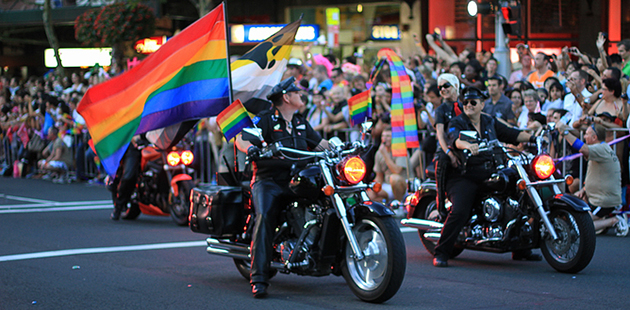 The Sydney Gay and Lesbian Mardi Gras festival is here again. The festival’s pinnacle and most attended event, the Parade, will see hundreds of thousands flocking to Sydney’s Oxford Street this Saturday for a mix of politics, revealing costumes, buffed bodies, flamboyance and celebration.
The Sydney Gay and Lesbian Mardi Gras festival is here again. The festival’s pinnacle and most attended event, the Parade, will see hundreds of thousands flocking to Sydney’s Oxford Street this Saturday for a mix of politics, revealing costumes, buffed bodies, flamboyance and celebration.
As is tradition, the sounds of more than 100 Dykes on Bikes revving their engines and blasting their horns will mark the beginning of the party. For the Queensland Dykes on Bikes, however, Mardi Gras is about more than leading the parade and attending parties.
Much interest in Mardi Gras is given to its historical legacy, to commodification and to questions of political identity. Seeking to build on these conversations, for the past three years I have been documenting the personal stories of those who travel vast distances each year to attend this event.
As part of this research, in a new article, published in Australian Geographer, I sought to examine the complex relations between the Queensland Dykes on Bikes and the Mardi Gras Parade.
Dykes on Bikes – a brief history
Who are the Dykes on Bikes? And what is their connection to Mardi Gras? The Dykes on Bikes is an international group for women who ride. In a subculture dominated by masculine working-class identities, the Dykes on Bikes play with femininities and masculinities through motorcycle skills, dress and riding styles. These performances challenge dominant sexual and cultural expectations of what a woman is and what a woman can do.
In addition to dominant conceptualisations of motorbike riding as synonymous with freedom, escape and individuality, the Dykes on Bikes celebrate and value notions of a collective identity and a sense of belonging. These are forged through the enforced rules and codes of the Chapter, and ideas of sticking and riding together.
The Dykes on Bike identity is not felt through following codes of membership alone; becoming, and remaining, a Dyke on Bike also occurs through riding together and leading pride parades. The Dykes on Bikes and pride parades are historically entangled.
The group first formed at the 1976 San Francisco Pride Parade when a small group of women motorbike riders informally came together to ride as part of the parade. One of these first riders is said to have coined the phrase “Dykes on Bikes”. Receiving traction in the media the group rode with the name. Growing in numbers the group became formally structured in the mid-1980s.
Today there are 22 chapters internationally, three of which are located in Australia (Queensland, Sydney and Melbourne); all of which are governed by the San Francisco Chapter. In 2003, the group changed its official name to the Women’s Motorcycle Contingent/ Dykes on Bikes. This move aimed to overcome simplistic understandings that all women who ride motorbikes are “dykes”.
Inspired by the original Dykes on Bikes leading of the 1987 San Francisco Lesbian and Gay Freedom Day Parade, the 1988 Mardi Gras Parade saw the arrival of the first Australian Dykes on Bikes.
The road to Mardi Gras
Today, around 20 Queensland Dykes on Bikes members ride annually from Brisbane to Sydney for Mardi Gras. The return journey is 1,800 kilometres. It takes four days – two each way. It entails more than 20 hours on the bike.
Riding a motorbike, in a group of 20, is not like driving a car. The body has to remain in the same position. The group has to remain in a choreographed formation. Each rider has to ride with their entire luggage. There are often heavy rains at this time of year; and lots of traffic. It’s challenging, tiring, yet characterised as incredibly enjoyable and rewarding by the group’s members.
For some members of the Queensland Dykes on Bikes, riding to Mardi Gras is conceived as more pleasurable than the event itself. It provides a unique opportunity to learn the rules and codes of the Chapter, pick up riding skills from other members and collectively practice riding in a group formation – opportunities not available through the shorter, Sunday rides normally organised for once a month.
Riding to Mardi Gras is therefore crucial in sustaining a sense of collective belonging among group members and performing a shared Dyke on Bike identity.
The parade, conversely, was surprisingly a source of anxiety for some members. The combination of waiting, managing the bike and voyeuristic screaming crowds led some riders to don gas and surgical masks to enable anonymity and create boundaries – practises that inhibited feelings of connection and belonging.
While travel to Mardi Gras is crucial to the Dykes on Bikes it is not the parade itself, but rather the immense journey, that serves as a fundamental dimension in sustaining a collective sense of belonging among group members.
Dykes on Bikes and the long road to Mardi Gras
By Anna de Jong, University of Wollongong
This article was originally published on The Conversation. Read the original article.
Image: by Will Choi
